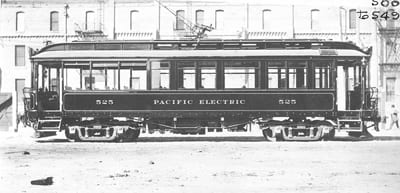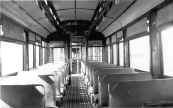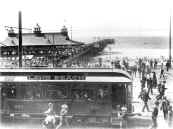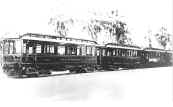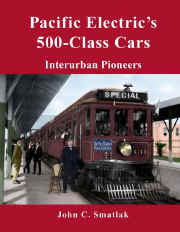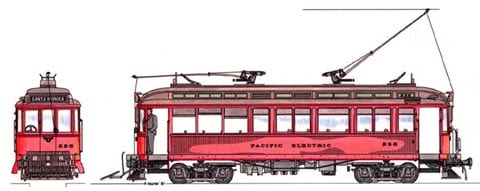
Original artwork Howard Nourse
The Original Cars
The wooden “500 class” rail cars date back to the very beginning of the Pacific Electric’s corporate existence. They were the first new cars ordered by the PE, and were also Southern California’s first standard gauge electric interurban cars. Built in three groups beginning in 1902, the “Fives” were used for light interurban and suburban service. They embodied all of the unique trademarks of early Southern California electric car design, including an open-air section and 5-window ends with distinctive curved corner glass. These same design elements were subsequently applied to hundreds of PE and Los Angeles Railway cars in the ensuing decades, becoming something of a trademark and earning the design its “Huntington” nickname. Although the Fives were quickly overshadowed in importance by their larger and faster interurban cousins, they did open service on several early PE interurban lines, and many of the cars served the system for over thirty years.
The Fives were divided into two basic groups of fifty cars each, the “Small” Fives, or 500s, ultimately numbered 500-549, and the “Big” Fives, or 550s, numbered 550-599. All of the cars were visually very similar, and unlike many of their contemporaries, all retained their open sections until retired. Cars 500-549 were built by the St. Louis Car Company over two orders between 1902 and 1909. Cars 550-599 were created in 1911-1912, when the PE extensively rebuilt a group of older cars inherited from a predecessor company. A 1922 article on equipment assignments in the Pacific Electric Magazine described the Fives as general-purpose utility cars:
“The 500-class cars, being smaller and lighter are used for short haul suburban service where frequent stops make high speed impossible and are used as general utility cars to meet emergencies in all class of service.”
The arrival of modern steel equipment, and ultimately the effects of the Great Depression (which cut heavily into transit ridership nation-wide in the early 1930s), combined to reduce the need for the Fives. Official retirements of the 500s began in 1934, although many had already been in storage for long periods of time. All of the Fives were retired from passenger service by 1940. Following retirement, the bodies of many 500s were sold to the public for use as “pre-fab” structures, finding use as storage buildings, restaurants and even as housing. Because they were reused in this way, several survived long enough to be preserved. Of the four carbodies known to exist today, three are at the Orange Empire Railway Museum in Perris, California.
The Replicas
The two replica Pacific Electric 500-class cars that now serve the Port of Los Angeles Waterfront Red Car Line were completed at a Port of LA facility in Wilmington, California, directly across the channel from where they are now running.
The replica 500s are a compromise between the original design and the requirements for a modern heritage trolley operating in an urban environment. The new cars feature a welded steel frame carrying a wooden superstructure that accurately replicates the appearance of a PE 500-class suburban car circa 1920. Vintage running gear obtained from the Seashore Trolley Museum was completely rebuilt with new wheels and refurbished motors. A new magnetic-contactor control system was provided by Goodman Equipment of Chicago, and the airbrake system has been designed by RPR associate Dave Garcia using all commercially-available components from WABCO and other suppliers.
The new cars seat 48 passengers, and are equipped for both high level and ground level boarding. Space for wheelchairs is provided through the use of folding seats and a slightly modified seating arrangement. As on the original cars, a traditional “California Type” open-air section has been incorporated, complete with heavy canvas curtains that can be pulled down during our occasional inclement weather.
It seems fitting that these new cars were patterned after the historic 500-class design which helped inaugurate service on the PE almost 100 years before.
Click here to download a scale drawing of the 500-series replica (requires Adobe Acrobat)

